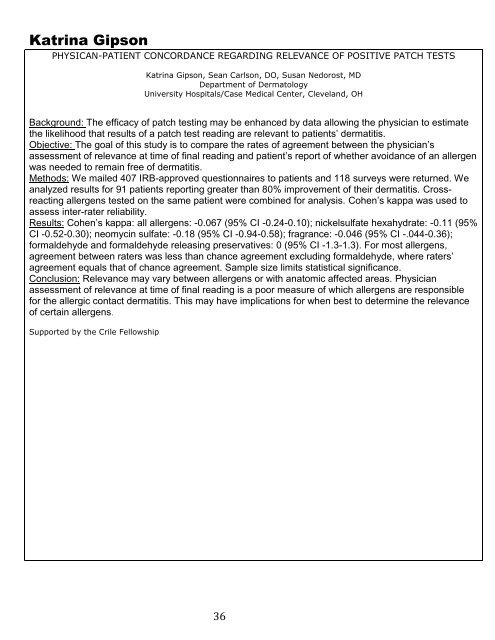student research day - Case Western Reserve University School of ...
student research day - Case Western Reserve University School of ...
student research day - Case Western Reserve University School of ...
You also want an ePaper? Increase the reach of your titles
YUMPU automatically turns print PDFs into web optimized ePapers that Google loves.
Katrina Gipson<br />
PHYSICAN-PATIENT CONCORDANCE REGARDING RELEVANCE OF POSITIVE PATCH TESTS<br />
Katrina Gipson, Sean Carlson, DO, Susan Nedorost, MD<br />
Department <strong>of</strong> Dermatology<br />
<strong>University</strong> Hospitals/<strong>Case</strong> Medical Center, Cleveland, OH<br />
Background: The efficacy <strong>of</strong> patch testing may be enhanced by data allowing the physician to estimate<br />
the likelihood that results <strong>of</strong> a patch test reading are relevant to patients’ dermatitis.<br />
Objective: The goal <strong>of</strong> this study is to compare the rates <strong>of</strong> agreement between the physician’s<br />
assessment <strong>of</strong> relevance at time <strong>of</strong> final reading and patient’s report <strong>of</strong> whether avoidance <strong>of</strong> an allergen<br />
was needed to remain free <strong>of</strong> dermatitis.<br />
Methods: We mailed 407 IRB-approved questionnaires to patients and 118 surveys were returned. We<br />
analyzed results for 91 patients reporting greater than 80% improvement <strong>of</strong> their dermatitis. Crossreacting<br />
allergens tested on the same patient were combined for analysis. Cohen’s kappa was used to<br />
assess inter-rater reliability.<br />
Results: Cohen’s kappa: all allergens: -0.067 (95% CI -0.24-0.10); nickelsulfate hexahydrate: -0.11 (95%<br />
CI -0.52-0.30); neomycin sulfate: -0.18 (95% CI -0.94-0.58); fragrance: -0.046 (95% CI -.044-0.36);<br />
formaldehyde and formaldehyde releasing preservatives: 0 (95% CI -1.3-1.3). For most allergens,<br />
agreement between raters was less than chance agreement excluding formaldehyde, where raters’<br />
agreement equals that <strong>of</strong> chance agreement. Sample size limits statistical significance.<br />
Conclusion: Relevance may vary between allergens or with anatomic affected areas. Physician<br />
assessment <strong>of</strong> relevance at time <strong>of</strong> final reading is a poor measure <strong>of</strong> which allergens are responsible<br />
for the allergic contact dermatitis. This may have implications for when best to determine the relevance<br />
<strong>of</strong> certain allergens.<br />
Supported by the Crile Fellowship<br />
36
















